
17 minute read
Demand through the roof
from Dairy Farmer December 2020
by AgriHQ
Lucy Appleton and Christo Keijzer make a range of cheeses from Buffalo milk farmed on their property at Glenroy. Photos: NatWick Photography
By Gerard Hutching
A Canterbury couple who make top quality buffalo cheese faced a tough time during the covid-19 lockdown but now that their market is back, it’s stronger than ever.
Everyone has their covid-19 story, but that of Lucy Appleton and Christo Keijzer is arguably more dramatic than most.
As the March lockdown hit, Lucy was still dealing with the aftermath of her mother’s recent death. But as well as mourning her mum, she was having to focus on the future of the couple’s buffalo dairy business, which largely hinged on supplying the restaurant trade with specialty cheeses such as mozzarella.
The gravity of the situation only became apparent as she did the rounds of their regular clients in Christchurch in late March.
“About 95% of our business was through restaurant trade throughout the South
Island,” Lucy says.
“When I went into Christchurch to do deliveries, every chef was like ‘Ah, um, can you take some of it back?’ I said ‘Sure, how much?’. They said leave us a tenth.”
As rapidly as the restaurant trade collapsed, online orders grew as they scrambled to rescue the business. Come Easter, a client’s brother who was a website designer and was “bored stupid” set about redesigning their website.
A “clever friend” came up with the name Cheesentials for the products – cheesemaking being an essential business during covid.
“People pay $89.90 and they get a selection with a 20% discount – and it went crazy. Most sales came from Auckland,” she says.
scamorza, stracciatella, camembert and celebrated mozzarella – which are sold to restaurants, online and at farmers markets.
Dung beetles will deliver upon the promise to restore and protect our freshwater while increasing production and drought tolerance.
We need to be smarter than just focusing on planting and fencing. MPI supports planting, fencing and “other initiatives to prevent farm runoff”. supports planting, fencing and “other initiatives to prevent farm runoff”.
And just to top off the challenging year, a buffalo got its horns stuck in a gate, which was picked up, catapulting Christo into a pole and breaking his arm.
The 40-hectare farm near Glenroy, Canterbury, is named Wairiri after the stream that runs through it and has been a 16-year labour of love for the couple who have only recently been able to devote their undivided attention to it. Lucy did bookkeeping and Christo

Continued page 10
FARM FACTS • Company: Wairiri Buffalo Ltd • Owners: Lucy Appleton and
Christo Keijzer • Location: Glenroy, Canterbury • Farm size: 40ha • Herd: 60 • Milking herd: 16 • Production target:
Thinking outside the [tree and fence lined] box Wairiri Buffalo produces a wide range of cheeses – feta, halloumi, ricotta, smoked
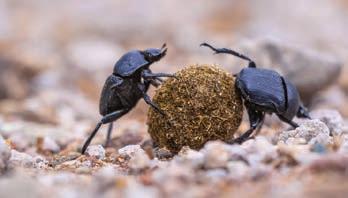

Without question that is where dung beetles fit in. Thinking outside the [tree and fence lined] box There is absolutely no better scientifically proven way of reducing overland flow than dung beetles. They deliver an up to 80% reduction in overland flow. This results in a 97% reduction in sediment, and equally includes reduced e. coli and phosphorus. The solution is right under our feet Dung beetles offer a remarkable natural sustainable solution to revitalise our soils and pastures, and can rehabilitate New Zealand’s Thinking outside the [tree and fence lined] box Dung beetles will deliver upon the promise to restore and protect our freshwater while increasing production and drought tolerance. There is absolutely no better scientifically proven way of reducing overland Seed dung beetles to fix the broken nutrient cycle and boost production. waterways – if we act now.Dung beetles will deliver upon the promise to flow, fixing the broken nutrient cycle, and boosting production than dung beetles. Farming For Our Future Generations Contact us Dung Beetle Innovations Shaun 021 040 8685 | shaun@dungbeetles.co.nz restore and protect our freshwater while increasing production and drought tolerance.
For more information or to order online go to www.dungbeetles.co.nzWe need to be smarter than just focusing on planting and fencing. MPI 68,352 litres total a year

ORDER NOW 10% DISCOUNT*
Wairiri Buffalo has a herd of 60 and milks 16 Buffalo twice-a-day, producing 68,352 litres a year. joins which means less risk, faster window required. calculations available. company – Firestone Building
Products.
For your nearest installation contractor call 0800 109 093
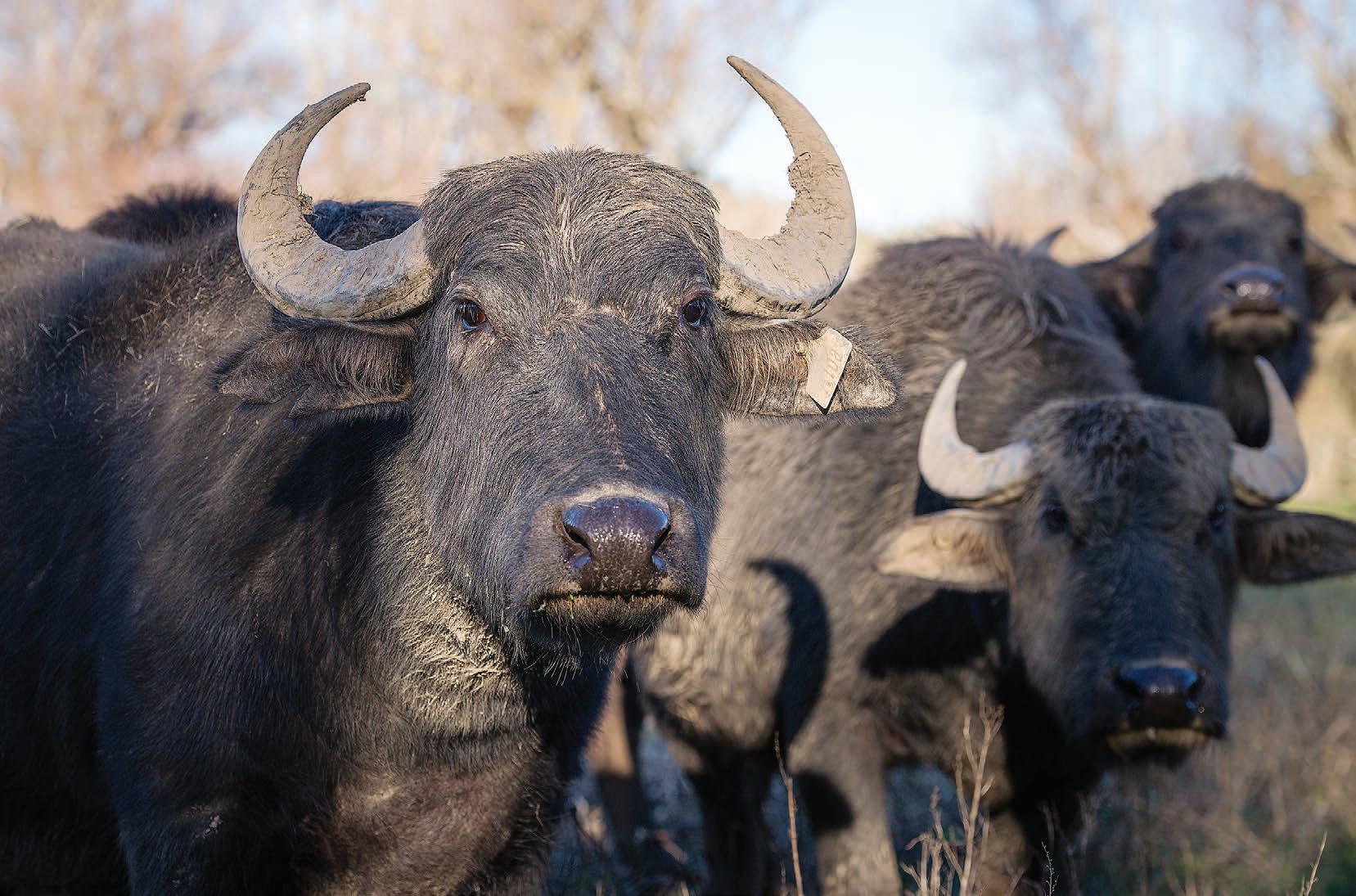
has been a maintenance engineer at Christchurch Airport.
Born in the Netherlands but disenchanted with the overcrowding in his native land, Christo arrived in New Zealand in 1992 with his eye on a job outdoors. He ended up working in tourism for 10 years before returning to his engineering roots.
Christo’s engineering background has proved indispensable when it comes to maintaining the milking shed and the cheese factory.
“[There were] so many small things that it would have cost a small fortune to bring in a specialist, so I’ve done a lot of it myself,” he says.
When they bought the property in the early 2000s, they had not settled on the use they would make of the land. In fact, it would take several years before their plans solidified. Having set up a small niche tourism business in the late 1980s called Flying Kiwi, Lucy was familiar with that size of operation.
As the couple mused over the possibilities, Lucy recalled the days when she ran the tourism business at Punakaiki and used to observe the water buffalo owned by pioneer Darcy Craze.
“My grandad was a farm manager in the UK, they supplied food into London stores; my dad was a foodie and so am I,” she says.
“I said I wanted land but not a massive lifestyle block; I want to work it and create something from it.
“For Canterbury, there’s quite a high
8000m3


EFFLUENT PONDS
Rolls up to 15m wide, therefore fewer installation and shorter good weather Design assistance and volume Material warranty from global rainfall here (600mm a year) and we’ve
Nationwide Firestone trained and accredited installation contractors.
Future proof – dependable performance, 50 year life expectancy even when exposed, 20 year Firestone
Over 120 million square metres installed worldwide. 30 years in the NZ lining business.
LK0103746©
material warranty.
or 021 280 7266
AUTHORIZED DISTRIBUTOR
Authorised importer and distributor of Firestone Building Products Email: vaughan@cosio.co.nz www.cosio.co.nz
Daughter Chloe Keijzer has learnt the fine art of making cheese from her mum Lucy Appleton.
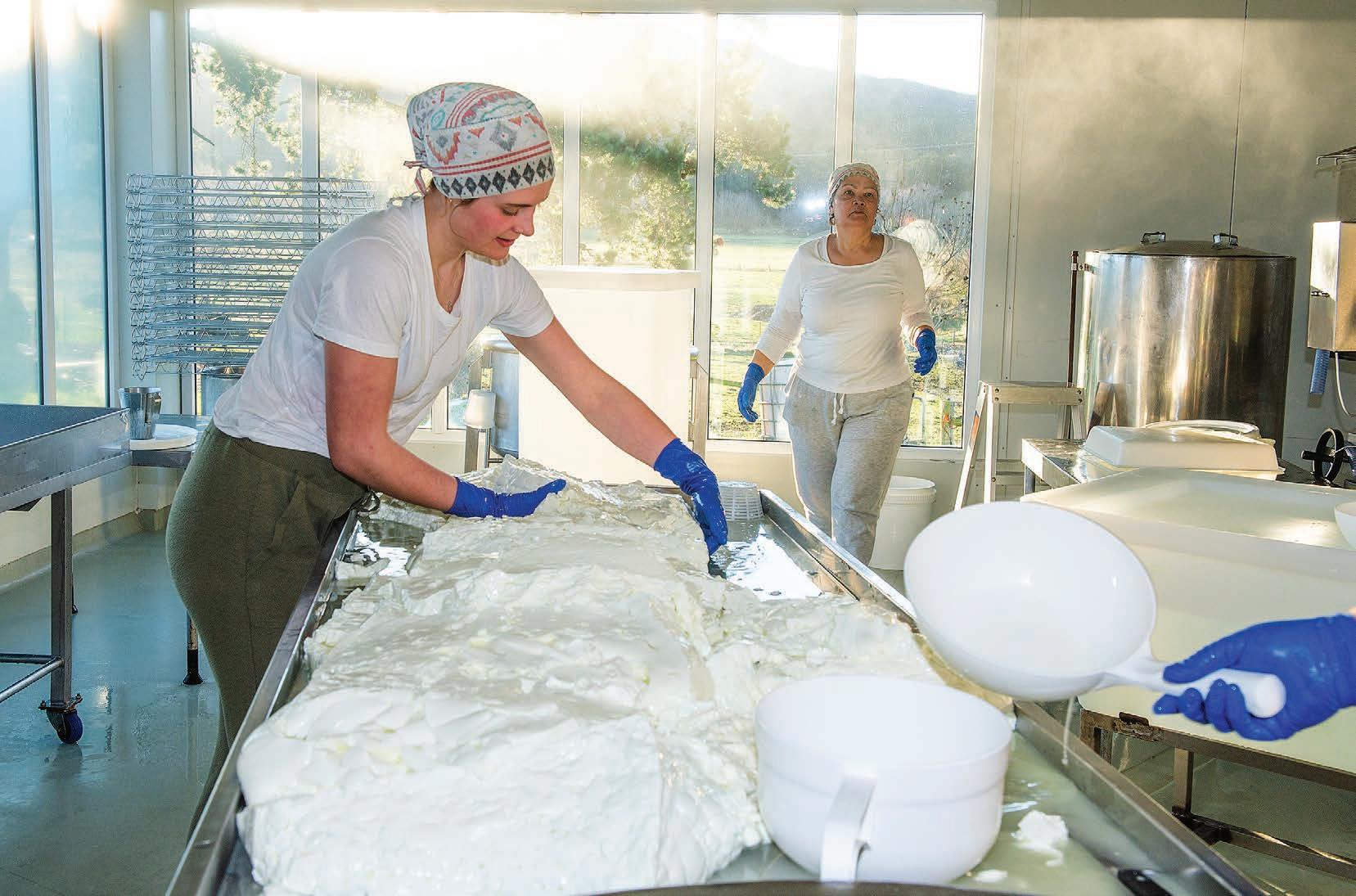
got soft soil, so I thought what animal is needed that suits this climate. That’s when we decided on buffalo.”
Lucy explains that a buffalo’s cloven hoof spreads to the size of a small dinner plate, which leaves a small imprint and does not pierce and pug the ground like cattle. As long as they can find wallows (or create them), they are content.
The couple’s approach to setting up the farm differed to that of the other major buffalo operation, Clevedon Buffalo just south of Auckland, which imported a large number of buffalo
The labneh, which is a bit thicker than Greek yoghurt and almost like soft cream cheese, gets a stir. from Australia in 2007 and now have over 200 head. She says that would have been too stressful considering they were still working full-time and raising two children.
Frequently though, they would find themselves working late in to the night – “moving fence breaks at 11pm” – as they tried to juggle different roles of working off and on-farm.
Starting gradually, they bought their first small herd from a Melbourne farmer who used Italian genetics, then invested heavily in a purebred bull. They initially bred from those two gene pools then started doing artificial insemination over the top – at any time during the year, according to need.
“We started a couple of months after Clevedon Buffalo, but we were like the tortoise, which has been really good, because we’ve been able to look after the genetics. We breed everything up here and we hand-raise the calves. We got rid of all the ones that were wild,” she says.
“We have bulls to look after the younger heifers because the young are quite difficult to artificially inseminate, so they go to the bull at age two. We’ve got only a couple of bulls, others are sold to

Wairiri imports embryos and semen from Italy and is slowly building up their herd. Christo hopes to eventually milk 20.
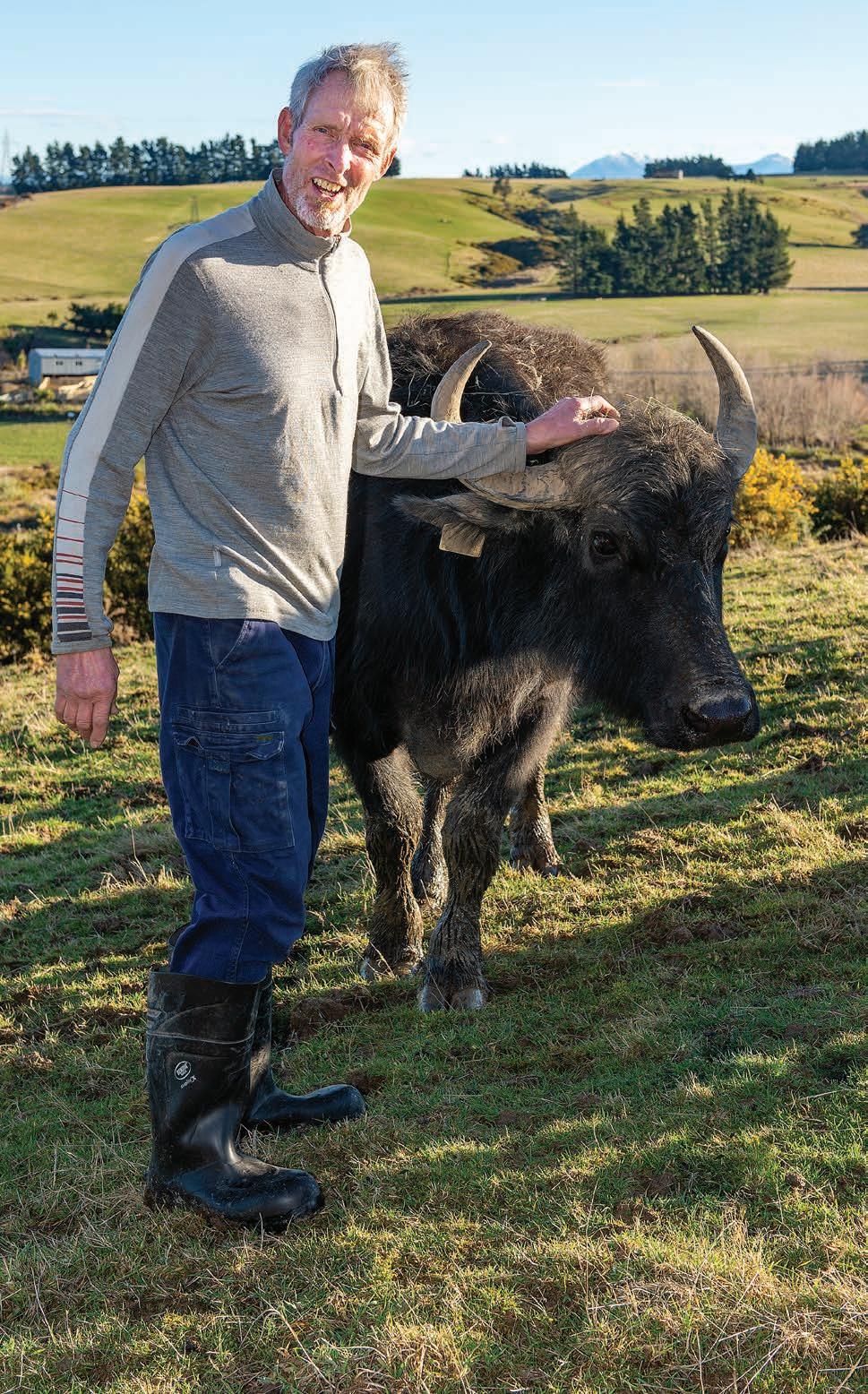
people with lifestyle blocks.”
Italian buffalo, known as the Mediterranean type, are believed to have been in that country for over a thousand years. Their milk is used for the famed Mozzarella di Bufala Campana, with most farms concentrated in the region south of Naples.
While New Zealanders cannot import live cattle from Italy because of the threat of Mad Cow disease, they can bring in embryos and semen, which is what Wairiri has been doing for the past eight years.
Gradually, they built up the herd before starting to milk them and venturing into commercial cheesemaking in 2013. Christo wryly observes that “all good things take time.”
“It’s very slow with buffalo because they don’t calve twins and have a longer gestation than cattle – 10 months – so we’re limited by how quickly we can breed good stock,” he says.
Today the farm supports 60 animals, of which 16 are milkers. They are aiming for 20 milkers.
Calving is year-round with no set time for when they are dried off. Some of them dry off after 9-10 months, Christo recalls one which took three years to dry off. The buffalo are milked twice-a-day, ensuring a higher yield and a longer milking life than if they were milked once-a-day. Target weaning weight is about 120kg.
The hand-raised calves are initially fed on lamb milk formula. They cannot be raised on cow’s milk.
“It’s been a long journey, getting rid of everything that doesn’t give good milk and doesn’t have good temperament or other issues,” Lucy says.
Despite milking only 16 animals, and the best yielding just 12 litres a day, they achieve much more productivity per cow than with cattle.
Buffalo are capable of living off a fairly frugal diet having originated in mountainous regions where they were known as “the poor man’s cow.” Lucy and Christo inherited a property of largely ryegrass and clover and have introduced some plantain and sunflowers. But they do not have a regrassing programme because they are trying to avoid too much tilling. They do not feed the buffalo on grain or imported palm kernel.
The farm has been organic from the start, although it is not certified because the effort is not worth the excessive paperwork. The buffalo are not given antibiotics and fertiliser is compost with the addition of lime.
The couple are committed to looking after the environment. They have fenced off and planted along waterways and are adding to the existing native reserves. About half the farm will be grazing and half will eventually be trees.
Christo says he does not know how he

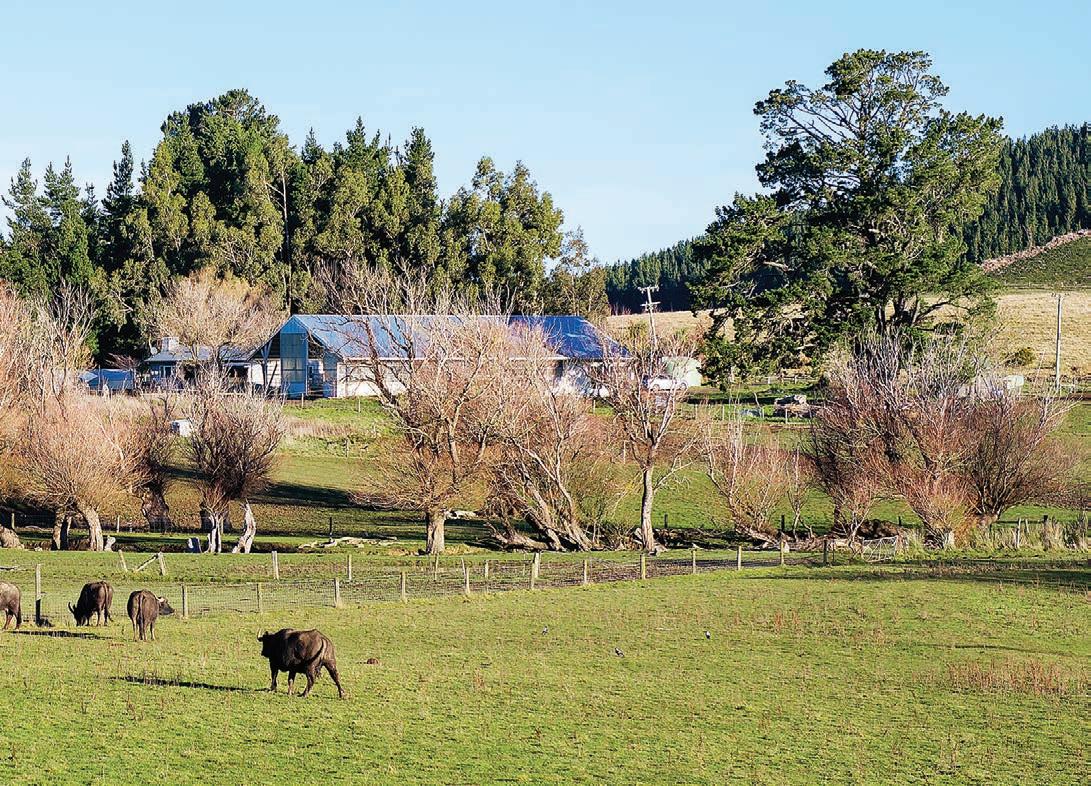
Lucy and Christo bought the 40-hectare property in the early 2000s, but it was several years before they decided to establish Wairiri Buffalo Farm.
could manage without the robot milking system which he had installed two years ago.
“We bring the whole herd in at six in the morning, they’re usually waiting outside,” he says.
“Then it’s a matter of pushing a button and milking and the machine cleans the teats. The computer knows how much milk to expect from each cow, and once the volume starts to go down the cups drop away automatically. Then when they’re finished, I push one button and it cleans the unit.”
The milking takes between one-anda-half to two hours. Christo concedes a manual herringbone system would be faster but at the cost of more work. Even if the herd were to grow, the robot would still be able to manage, except it would take longer to milk them.
The robotic system is a handy way of keeping on top of health issues such as mastitis because it registers if there are any problems. It feeds information on milk production directly into a computer.
Compared to cattle, the couple says buffalo have a lot of character.
“They have a strong pecking order. If one lower down pushes in ahead of the others, she will get punished by those higher in the order. I have to stand at the
Christo in the milking shed housing the robot milking system he had installed two years ago. Milking can take up to two hours. top, I have to be the boss,” he says.
Buffalo produce A2 milk, which finds a ready-market in the Indian community, because it is what Indians grew up with. Besides drinking it, they use it to make paneer cheese, a staple of Indian cuisine.
Swedish researchers Mikaela Ståhl Högberg and Ole Lind note that comparing buffalo to cow milk, buffalo contains significantly more total solids, higher levels of the important minerals like calcium and phosphorus, substantially less cholesterol, more of the natural antioxidant tocopherol and more vitamin A.
Wairiri produces a wide range of cheeses – feta, halloumi, ricotta, smoked scamorza, stracciatella, camembert and the celebrated mozzarella; the word being derived from the Italian term “to stretch.” The silky textured milk makes it a favourite for using in coffee.
Lucy has been the head cheesemaker for the past six years, but her 16-yearold daughter Chloe has learned to the point where she can handle a batch, and a young local man has also trained as a cheesemaker onsite. Overall, the business employs six people.
In order to learn the intricacies of cheesemaking, Lucy contacted one of Italy’s largest buffalo farms near Salerno, just south of Naples, to ask if she could visit and learn onsite. Before departing New Zealand she learned conventional Italian, only to discover that region had a difficult to understand dialect.
“I could still ask questions, I just couldn’t understand the answers,” she says.
“The head cheesemaker was extremely proud of his work and had extremely high standards. He was very stern with me – kind but stern. The family farm was a huge organic operation using four milking robots and supported 60 staff. They wanted me to stay for six months but I could only stay two weeks.

Christo Keijzer with his milking buffalo. He is originally from the Netherlands and has an engineering background.

“They have a strong pecking order. If one lower down pushes in ahead of the others, she will get punished by those higher in the order. I have to stand at the top, I have to be the boss.” Christo Keijzer
“It was extremely exhausting. Every night I would phone a friend who was fluent in both English and Italian, and he was able to help me translate terms.”
As she was to learn, mozzarella cheesemaking on this particular Italian farm was different to the way she now makes it. For a start, they do not pasteurise the milk, whereas in NZ, legal requirements state milk has to be pasteurised.
“They don’t pasteurise, they use a fresh culture, whereas we pasteurise and we
Benefits of buffalo milk
Buffalo milk has a higher fat content about 7-8% more than cows at 3-4%, therefore is thicker than cow’s milk. It is heavier and takes time to digest, so keeps you fuller for a longer period of time.
Buffalo milk contains all nine amino acids and contains 10-11% more protein than cow milk – around 8.5g of protein. This is excellent for building muscles and preventing muscles loss.
Buffalo milk contains a low amount of cholesterol, which makes it an excellent choice for people suffering from diseases like hypertension, kidney problems, and obesity. It has high amounts of calcium and is also a source of casein-derived peptides that may promote bone health and reduce your risk of osteoporosis.
It is more heat resistant and the rich creamy texture is perfect for producing butter, cream and yoghurt.
If you are looking for a good night’s sleep, drink buffalo milk as it is considered to be sleep-inducing. don’t use a fresh culture, although we could, but it would be very difficult,” she says.
“Every day they’re making cheese so they can keep their culture going, and if their culture fails, they can just go to the farm next door. We can’t. We have to use packet culture.”
Lucy accepts Italian cheese is cheaper than Wairiri’s but points out there are good reasons for the price difference. For a start, Italian (and European in general) farmers are subsidised to the tune of up to 50%. And don’t get her started on the environmental and animal welfare comparisons.
“In Italy they’re all inside. I had an Italian cheesemaker tell me we would not be able to make mozzarella from animals that eat grass and live outside because they need to eat grain to get the protein high.
“Do people want to eat mozzarella from an animal that’s constantly on antibiotics and grain-fed, or would they like to enjoy fresh grass-fed mozzarella?” she asks.
“Any chef who tries our cheeses won’t go near that [the imported product] anymore.
“Now that we’re training up another cheesemaker to make the various
cheeses, I have more time to deal with the chefs.
“While we lost some of the original tourist-based restaurant trade, we’ve gained a lot of others. The chefs like us because we do the traditional Italian cheeses like the stracciatella, but they use it untraditionally.
“One chef put it with seaweed and wasabi, which was a fantastic dish. We had a Michelin chef helping me out on the farm and he cooked all the meals. It was incredible the way he served the mozzarella; one of my favourite dishes he made was with a warmed, mild salsa of fresh tomato and herbs, with the warmth gradually moving into the mozzarella,” she says.
Besides selling into restaurants, which have gone “crazy” since the lifting of lockdown, and the online platform, the couple also take their wares to popular farmers’ markets in Lyttelton and Dean’s Bush. The most sought-after product is probably the mozzarella, although Lucy says they all sell well. n
Video link: bit.ly/OFSwairiri Yolanda de Ruiters and Chloe Keijer get stuck into making mozzarella.

SUCCESS STORY Neil’s reaping the rewards of mixing over separation
Neil runs a 140ha dairy farm in New Plymouth milking approximately 380 cows....
Originally Neil’s effluent system used a weeping wall for solids separation, and he’d spread with his solids spreader when he had time... However the system wasn’t working out as he’d envisioned. He entrusted Nevada to design, supply and install a more efficient and effective effluent management system. This included a new 25m x 25m HDPE lined effluent pond, PC pump and EL9 shore mounted electric stirrer. “Lining the pond is important to make sure you’ll stay council compliant with no leaks. HDPE lining is recommended because it’s cost effective, reliable, and lasts a very long time. A PC pump and shore mounted stirrer are the way to go when you can get electricity running down to the pond. Not only is this the most efficient and cost effective way to get the job done, it’s also the safest in not having anyone need to venture out onto the pond for maintenance. ” Lloyd Thomas, Nevada Nevada project managed the entire operation from contracting local company Excavat to dig the pond, through to installation of the pump and stirrer. With this new system set up, Neil simply spreads with an irrigator that he sets to run for two hours and then the pump switches off on a timer. As for the old solids spreader, it’s not quite retired yet, and neither is the weeping wall - the weeping wall was converted into a sandtrap, and the solids spreader is used to empty it when needed. “It’s [the new system] much easier than the old system. The pump is awesome. Makes things much easier with some storage. The stirrer’s great. Pivots from side to side and creates a good stirring action around the pond.” Neil Ryan










